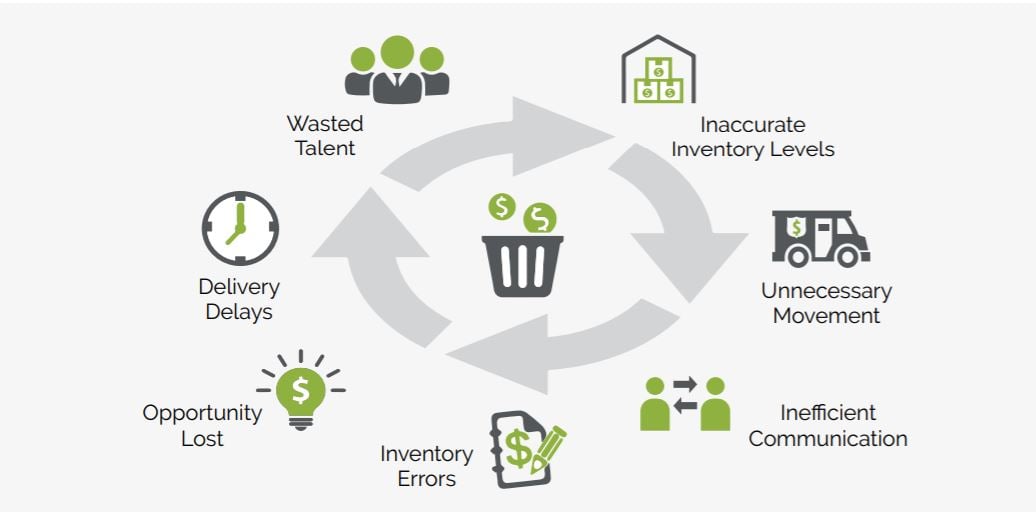Over the last few months, we have covered the seven areas of waste in banking, and these wastes can be found in the cash inventory management process. Remember, waste can be described as inefficiencies in processes in any industry, and Toyota originally pioneered the process to identify “waste” that could be removed in order to optimize efficiency in their industry. The seven areas of waste in banking can be used to help you identify and eliminate current inefficiencies in your cash operations.
Let’s recap the seven areas of waste that are killing your bank’s efficiency:

Having too much cash, or too little, are both detrimental to a financial institution’s efficiency and create waste in different ways. Running out of varying denominations results in poor customer satisfaction by not meeting customer demands within a timely manner. Alternatively, sitting on excess cash can negatively impact risk and insurance, and also creates a larger than necessary nonearning asset.
A cloud-based supply chain management software can help financial institutions forecast their actual cash usage down to the denomination level at each cash end point. This ensures banks and credit unions never run out of cash, but also aren’t keeping more than necessary at the branch. It’s time for banks and credits unions to change the way they think about cash. Read more.
2. Unnecessary MovementBanks and credit unions do not often consider the risk or expense associated with unnecessary cash movement around their network. The truth is, there can be a significant amount of waste hidden in the process of moving cash to and from your institution and cash points. Read more.
3. Inefficient CommunicationWhen people think about inefficient communication within an organization, they automatically think about delays between emails, phone calls, etc., but what is the true cost of inefficient communication? Inefficient communication can have many detrimental effects on your financial institution’s overall efficiency that result in waste in the form of time and money. When communication is ineffective or erroneous, it leads to extra internal and external emails, phone calls, report pulling, and additional charges. Read more.
4. Inventory ErrorsAs we’ve previously mentioned, having too much or too little inventory can be detrimental to your customers and your financial institution. However, inventory errors can and do occur, which create waste in the cash ordering process within your bank or credit union. Occasionally, a branch or device may receive inaccurate inventory, which leads to a number of secondary actions to rectify the problem. These secondary actions are an additional drain on your staff’s time and can pose additional costs or risks to your financial institution. Read more.
5. Opportunity LostCircumstances change over time that determine your goals, and lost opportunities can emerge as a result. The negative impact and expense from lost opportunities are hard to track, yet they are all too real. For example, having too little cash can mean you miss out on the opportunity to minimize armored car deliveries, thus saving on transportation costs. On the contrary, having excess cash equates to large amounts of money sitting idle when it could have been reinvested to create a profit. Read more.
6. Delivery DelaysDelays in your financial institution can come in many forms and are sometimes inevitable. Cash orders can be delayed from an unexpected transportation change or because a holiday falls on a scheduled delivery day. In addition, there are other delays that can be caused when a branch does not place their cash order on time. Not all delivery delays are within the control of a financial institution, but you must prepare for unforeseen circumstances and minimize the waste of time and money that results from those that are. Read more.
7. Wasted TalentBranch and ATM staff often use antiquated processes such as email and spreadsheets to manually calculate orders and deposits as well as communicate information internally. Additionally, money suppliers and armored car carriers have their own online systems where bank staff is required to manually ten-key type their orders and deposits. This waste of time and resources can be highly interruptive to the efficiency of your customer service model because your staff is performing administrative work as opposed to high value tasks such as supporting and selling to your customers.
Your team is your most valuable resource and your largest expense, so it’s critical to give them the opportunity to maximize their time by allowing room for high value activities. It’s also important to note that when your team feels their work is important and time is spent efficiently, overall job satisfaction and employee culture is positively impacted. Read more.
To learn more about where to look for waste and areas of improvement in the cash supply chain, click the link the link below to download our e-book, “The 7 Areas of Waste That are Killing Your Bank’s Efficiency.”
